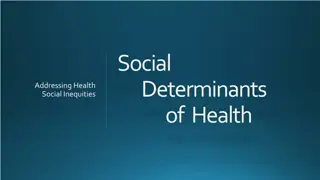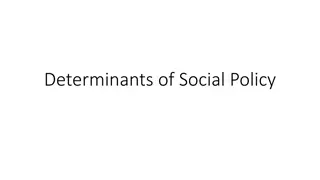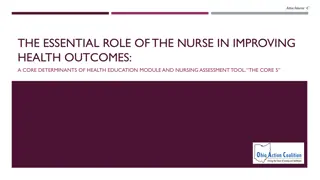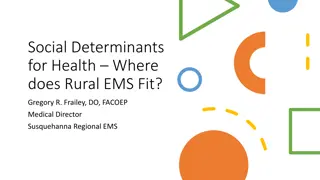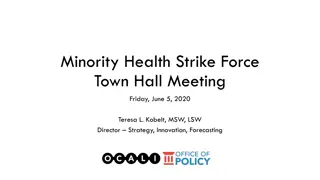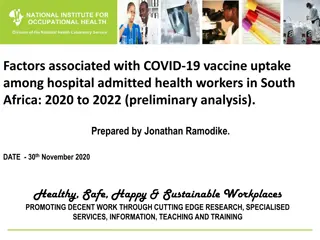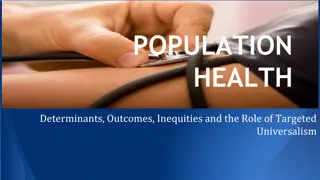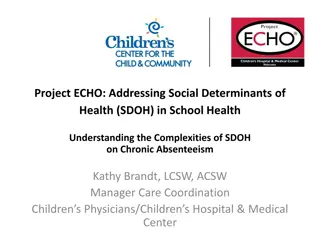Insights on COVID-19 Impact: Changes in Health Determinants
Explore the technical supplement report on the wider determinants of health amid the COVID-19 pandemic in July 2021. The report delves into the impact on friends, family, community, education, income, employment, housing security, and homelessness. Detailed analyses reveal the effects on personal relationships, family dynamics, and societal connections during the challenging times of lockdowns and restrictions.
Download Presentation

Please find below an Image/Link to download the presentation.
The content on the website is provided AS IS for your information and personal use only. It may not be sold, licensed, or shared on other websites without obtaining consent from the author. Download presentation by click this link. If you encounter any issues during the download, it is possible that the publisher has removed the file from their server.
E N D
Presentation Transcript
Technical supplement 3 for the COVID-19 impact inquiry report Changes in the wider determinants of health July 2021
July 2021 Slide 2 COVID-19 impact inquiry: technical supplement About this slide deck This is the third in a series of four slide decks that accompany the COVID-19 impact inquiry report. These slide decks provide additional evidence and analysis to support arguments made within the main report for readers who are interested. Specifically, these slides contain: downloadable versions of the figures presented in the report. These can be copied and used as long as credit is given to the Health Foundation: Originally published by the Health Foundation as part of its COVID-19 impact inquiry [link]. analysis referenced in the report where details are not published elsewhere additional charts produced as part of the analysis selected evidence that was reviewed as part of the inquiry but not included in the report This slide deck relates to section four of the report. The slides follow the sequence of the points made in the report. If you have any queries about the content of these decks, please contact COVID-19impactinquiry@health.org.uk.
July 2021 Slide 3 COVID-19 impact inquiry: technical supplement Contents 1. Friends, family and community 2. Education 3. Income and employment 4. Housing security and homelessness
1. Friends, family and community
July 2021 Slide 5 COVID-19 impact inquiry: technical supplement Personal relationships Health Foundation analysed YouGov data from the first lockdown and reported that: 60% of young people aged 16 29 years felt concerned about the impact of lockdown on their friendships, compared to 34% of 30 59-year-olds. 40% of 18 24-year olds reported speaking less to family and friends outside their house than they did before lockdown. The UCL COVID-19 Social Study found that people living alone, with lower household income, and with a diagnosed mental or physical health condition have received consistently lower support (approximately 10-20% lower). A small survey by the Belong Network in June 2020 gave further perspectives on the general population: 51% of respondents reported a loss of connection with their friends and 54% with work colleagues. 47% reported increased connection with their family, 45% with neighbours, and 31% with people from their local area. Older people and people with lower incomes were more likely to report feeling less connected to others. A follow-up survey in December found a lower sense of connection with family and friends.
July 2021 Slide 6 COVID-19 impact inquiry: technical supplement Family dynamics Analyses by the IFS using the UKHLS data and time-use survey data from the first lockdown found that: Mothers reported spending 1.7 hours more a day on household responsibilities and 2.3 hours more on childcare than fathers. The split of household responsibilities differed when one parent was furloughed or no longer working: where mothers stopped paid work, they carried out almost twice the volume of domestic tasks as fathers. Where fathers stopped paid work, childcare and housework were split equally. In families where fathers earned more, mothers did double the housework. Conversely, in families where mothers earned more, mothers still did slightly more than an equal share of the housework than fathers. Mothers also did more childcare on average, regardless of whether they were the higher earner. ONS reported that in April 2020 lockdown, a similar proportion of fathers and mothers reported home schooling. This was different in the January 2021 lockdown when 67% of women reported they were home schooling, compared with 52% of men.
July 2021 Slide 7 COVID-19 impact inquiry: technical supplement Community cohesion Neighbours started connecting and looking out for each other more than usual and informal support groups in local areas organised to support people in need: By the end of May 2020 over 2000 groups were listed on the mutual aid website. At least 5,000 neighbourhood-based mutual aid groups were created on the covidmutualaid website. More than 750,000 NHS volunteers signed up to provide support to vulnerable people through Check In and Chat, Community Response, and NHS Patient Transport. Analysis of the UKHLS (Borkowska and Laurence 2020) found perceived neighbourhood cohesion had declined compared to levels seen in 2011/12 and 2014/15. This decline was higher for people living in the most deprived areas, those with lower levels of education, those younger than 35 and members of certain ethnic minority communities.
July 2021 Slide 8 COVID-19 impact inquiry: technical supplement National unity ONS collected data from 24 April to 28 June 2020 on perceptions of unity and division. Between 24 April and 3 May 2020, 21% believed that Britain was very or somewhat united before the coronavirus pandemic and 57% said they thought that Britain would be united following recovery from the coronavirus pandemic. Over the period as a whole from 24 April to 28 June 2020 the proportion of adults who thought that Britain would be more united after the pandemic declined from 57% to 28%. More adults on average thought that Britain would be united after recovery from the coronavirus (COVID-19) pandemic (46%) than thought that it was united before the pandemic (24%). A small survey by the Belong Network in June 2020 found almost half of the respondents (49%) perceived the UK becoming more divided, with smaller numbers perceiving more unity (35%). Using available and a newly commissioned survey the British Academy found that perceptions of national unity were lower than perceptions of local unity and declined through the pandemic.
2. Education
July 2021 Slide 10 COVID-19 impact inquiry: technical supplement Learning loss The Department for Education (DfE) reported analyses conducted by the Education Policy Institute and Renaissance Learning based on the National Pupil Database and Star Reading and Star Maths computer-adaptive assessments conducted in autumn 2020 and spring 2021. By autumn 2020/21, primary school pupils had experienced 1.8 months of learning loss in reading and 3.7 months in mathematics. Secondary school pupils also experienced a loss of 1.7 months in reading. It noted regional disparities. Reading loss among primary school pupils was highest in the North East and Yorkshire and Humber. The greatest learning loss in mathematics among primary school pupils and the greatest learning loss in reading among secondary school pupils both occurred in Yorkshire and Humber. In spring 2021, learning loss increased in reading and reduced in mathematics for primary school children. It was estimated at 2 - 2.3 months in reading and 3.1 - 3.6 months in mathematics.
July 2021 Slide 11 COVID-19 impact inquiry: technical supplement Pupils reaching expected levels Juniper Education analysed data from 6,000 primary schools collected in autumn 2019, summer 2020 and autumn 2020. It found that: In summer 2020, the percentage of pupils from Years 2 to 6 working at, or above, expected levels fell by around 20 percentage points compared with autumn 2019. The fall in attainment was across the board. The data revealed a reduction in pupils reaching expected levels of learning in reading, writing and maths. Maths fell the most, with an attainment drop of 21.4 percentage points. Writing fell by 18.1 percentage points. Disaggregating the data by years, the impact of disruption varied. In Year 6, pupils working at the expected level in reading dropped by only 2.6%, compared to a fall of 22.2% in Year 1, with similar scale falls in Years 2 5. By autumn 2020, the percentage of pupils working at, or above expected levels had improved but was about 7% lower than in autumn 2019 for reading, writing and maths.
3. Income and employment
July 2021 Slide 13 COVID-19 impact inquiry: technical supplement Coronavirus Job Retention Scheme and employment Statistics from HMRC show that between March 2020 and April 2021, the Coronavirus Job Retention Scheme had supported 11.5 million jobs. The Bank of England noted that without the Coronavirus Job Retention Scheme there would have been considerably larger increases in unemployment. Resolution Foundation conducted surveys between April 2020 and March 2021. They found that: In April 2020, 32% of the working population were no longer working or furloughed or working fewer hours. Labour market outcomes improved after the first wave and by March 2021, this had reduced to 14%. Of those furloughed between April 2020 and January 2021, the majority had returned to work. However, 7% were no longer working and 34% of those furloughed remained furloughed in March 2021. This varied by hourly pay only 17% of the highest paid workers were still furloughed compared to 38% of the lowest paid workers. In May 2021, the Bank of England estimated unemployment would peak at just under 5.5% in 2021, lower than previous estimates. This is partly due to the extension of the Job Retention Scheme to September 2021.
July 2021 Slide 14 COVID-19 impact inquiry: technical supplement Access to financial support A study conducted by Welfare at a (Social) Distance compared two pieces of research one survey with non- claimants and benefit claimants and two surveys with the general population between 6 May and 10 August 2020: The researchers estimated that 220,000 people who thought they were eligible and 280,000 390,000 people who wrongly thought they were ineligible did not claim universal credit. The main reasons cited for not claiming were perceived stigma and 'hassle . In January 2021, The Standard Life Foundation conducted a survey of 6,700 people across the UK. The findings indicated that an estimated 3.8 million adults were excluded from the Coronavirus Job Retention Scheme and the Self-Employment Income Support Scheme.
July 2021 Slide 15 COVID-19 impact inquiry: technical supplement Universal credit uptake by life expectancy Female life expectancy at birth, 2017-19 and increase in share of working age population receiving Universal Credit between March and August 2020 Greater increases in the share of the population receiving Universal Credit have tended to be in more deprived areas and those with lower life expectancy.
July 2021 Slide 16 COVID-19 impact inquiry: technical supplement Change in employment and pay by socioeconomic status Changes to employment earnings by income quintile, UK, 2020 Pay or employment reduced by more for people living in families with the lowest income.
4. Housing security and homelessness
July 2021 Slide 18 COVID-19 impact inquiry: technical supplement Evictions Based on a YouGov survey in May 2021, the Joseph Rowntree Foundation estimated that: 400,000 households or 5% of all renters have been served an eviction notice or been told they might be evicted. 450,000 households reported being in rent arrears 18% of these for more than four months. Without the eviction ban, landlords are required to give only four weeks' notice. 11% of renters were worried about being evicted in the following three months. Half of these families had children. Along with families with children (21% vs 9%), ethnic minority communities (18% vs 10%) and those on low income (24% vs 8%) are more likely to be worried than their counterparts. Compared with mortgagers, renters are more likely to be worried about being evicted (11% vs 5%) and being in rent or bill arrears (19% vs 6%).
July 2021 Slide 19 COVID-19 impact inquiry: technical supplement References Leavey C, Eastaugh A, Kane M. Generation COVID-19 [Webpage]. Health Foundation. 2020.(www.health.org.uk/publications/long-reads/generation-covid-19) Fancourt D, Bu F, Mak HW, Steptoe PA. Covid-19 Social Study: Results Release 27. UCL. 2021. (https://b6bdcb03-332c-4ff9-8b9d- 28f9c957493a.filesusr.com/ugd/3d9db5_56829e7218df4524b304636d226a6198.pdf) Abrams D, Lalot F, Broadwood J, Platts-Dunn I. Beyond Us and Them Perception of Covid-19 and Social Cohesion. Belong. 2020. (www.belongnetwork.co.uk/resources/beyond-us-and-them- perception-of-covid-19-and-social-cohesion-july-2020-report) Abrams D, Lalot F, Broadwood J, Hayon KD. Community, Connection and Cohesion during COVID-19: Beyond Us and Them Report. Belong. (https://www.belongnetwork.co.uk/wp- content/uploads/2021/02/Belong_InterimReport_FINAL-1.pdf) Andrew A, Bandiera O, Dias MC, Landais C. The careers and time use of mothers and fathers. Institute for Fiscal Studies. 2020. (https://ifs.org.uk/publications/15360) Andrew A, Cattan S, Dias MC, Farquharson C, Kraftman L, Krutikova S, et al. How are mothers and fathers balancing work and family under lockdown? Institute for Fiscal Studies. 2020. (www.ifs.org.uk/publications/14860) Office for National Statistics. Coronavirus and the social impacts on Great Britain [Webpage]. Office for National Statistics. 2020. (https://www.ons.gov.uk/peoplepopulationandcommunity/healthandsocialcare/healthandwellbein g/bulletins/coronavirusandthesocialimpactsongreatbritain/19february2021#homeschooling) Stansfield J, Mapplethorpe T, South J. The community response to coronavirus (COVID-19) Public health matters [Webpage]. PHE Blog. 2020. (https://publichealthmatters.blog.gov.uk/2020/06/01/the-communityresponse-to-coronavirus- covid-19) Copps J. Local authorities can help make mutual aid a positive legacy of COVID-19. The MJ. 2020. (https://themj.co.uk/Local-authorities-can-help-make-mutual-aid-a-positive-legacy-of- COVID-19/217533) NHS army of volunteers to start protecting vulnerable from coronavirus in England [Webpage]. NHS England. 2020. (www.england.nhs.uk/2020/04/nhs-volunteer-army-now-ready-to-support- even-more-people) Lockdown legacies: the 10 shifts in consumer behaviour for retailers to be aware of [Webpage]. Barclaycard. 2021. https://home.barclaycard/press-releases/2021/03/Lockdown-legacies/ Borkowska M, Laurence J. Coming together or coming apart? Changes in social cohesion during the Covid-19 pandemic in England. Eur Soc. 2021;23(S1):S618 36. (www.tandfonline.com/doi/full/10.1080/14616696.2020.1833067) Office for National Statistics. Unity and division in Great Britain [Webpage]. Office for National Statistics. 2020. (www.ons.gov.uk/peoplepopulationandcommunity/wellbeing/bulletins/unityanddivisioningreatbrit ain/24april to28june2020) The British Academy. The COVID decade: understanding the long-term societal impacts of COVID-19. British Academy for the Humanities and Social Sciences. 2021. (www.thebritishacademy.ac.uk/documents/3238/COVID-decade-understanding-long-term- societal-impacts-COVID-19.pdf)
July 2021 Slide 20 COVID-19 impact inquiry: technical supplement References Renaissance Learning & Education Policy Institute. Pupils' progress in the 2020 to 2021 academic year: interim report. Department for Education. 2021. (www.gov.uk/government/publications/pupils-progress-in-the-2020-to-2021-academic-year- interim-report) Juniper. The impact of the COVID-19 pandemic on primary school children s learning. Juniper. 2021. (https://21e8jl3324au2z28ej2uho3t-wpengine.netdna-ssl.com/wp- content/uploads/juniper_folder/Juniper-Education-National-Benchmark-Dataset-Report.pdf) HMRC. Coronavirus Job Retention Scheme statistics: 3 June 2021. Gov.uk. 2021. (https://www.gov.uk/government/statistics/coronavirus-job-retention-scheme-statistics-3-june- 2021/coronavirus-job-retention-scheme-statistics-3-june-2021#cumulative-totals) Bank of England. Monetary Policy Report. Bank of England. 2021 May. (https://www.bankofengland.co.uk/-/media/boe/files/monetary-policy-report/2021/may/monetary- policy-report-may-2021) Cominetti N, McCurdy C & Slaughter H. Low Pay Britain. Resolution Foundation. 2021. (https://www.resolutionfoundation.org/app/uploads/2021/06/Low-Pay-Britain-2021.pdf) Geiger BB, Scullion L, Summers K, Martin P, Lawler C, Edmiston D, et al. Non-take-up of benefits at the start of the COVID-19 pandemic. Welfare At a Social Distance. 2021. (https://62608d89-fc73-4896-861c- 0e03416f9922.usrfiles.com/ugd/62608d_602f7840f4114361a4dbf6d007d3825b.pdf) Aiden H, Wilson H. Reconditioning the benefits system for a stronger COVID-19 recovery [Webpage]. Health Foundation. 2021. (https://www.health.org.uk/news-and- comment/blogs/reconditioning-the-benefits-system-for-a-stronger-covid-19-recovery) Collard S, Collings D, Evans J, Kempson E. Who are The Excluded ?: Findings from the 4th Coronavirus Financial Impact Tracker Survey. Standard Life Foundation & University of Bristol. 2021. (https://www.aberdeenstandard.com/docs?documentId=GB-180221-142931-1) Hetherington G. As 400,000 renters face eviction, JRF warns the UK risks a two-tier recovery [Webpage]. Joseph Rowntree Foundation. 2021. (https://www.jrf.org.uk/press/400000- renters-face-eviction-jrf-warns-uk-risks-%E2%80%98two-tier-recovery%E2%80%99)
Thank you Learn more: Read the COVID-19 impact inquiry report: Unequal pandemic, fairer recovery See all content from the COVID-19 impact inquiry Discover all of the inquiry's technical supplements: Supplement 1: COVID-19 health outcomes Supplement 2: The pandemic s implications for wider health and wellbeing Supplement 4: Experiences of some groups disproportionately affected by the pandemic. Sign up for ongoing updates about this work.



